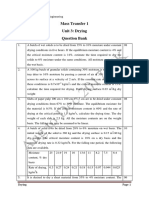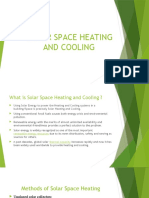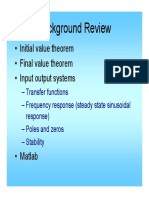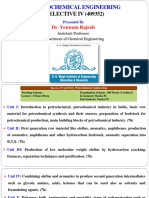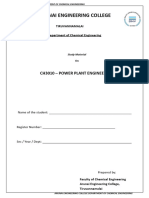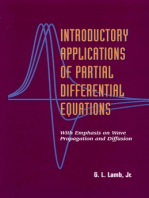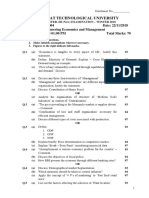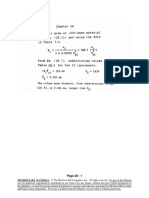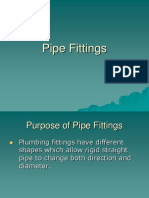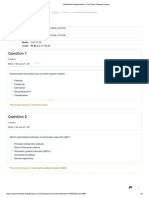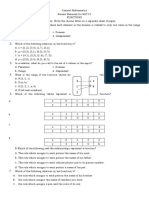IPC Questions
IPC Questions
Uploaded by
Bhakti MahbubaniCopyright:
Available Formats
IPC Questions
IPC Questions
Uploaded by
Bhakti MahbubaniOriginal Description:
Original Title
Copyright
Available Formats
Share this document
Did you find this document useful?
Is this content inappropriate?
Copyright:
Available Formats
IPC Questions
IPC Questions
Uploaded by
Bhakti MahbubaniCopyright:
Available Formats
L.J.
Institute of Engineering & Technology
Semester: V(2016)
Subject Name: INSTRUMENTATION AND PROCESS CONTROL
Subject Code:2150504
Faculty: Mr. Mukesh M Mahbubani
Sr
No
1
Marks
CHAPTER 1 Introductory Concepts
SHORT QUESTIONS
Define steady state process:A process is said to be at steady state when none of the variables
are changing with time
DESCRIPTIVE QUESTIONS
1
7
With suitable example describe the hardware elements of control
system. (Dec 2014)[LJIET]
CHAPTER 2 Modeling tools for Process Dynamics
1
2
3
4
5
SHORT QUESTIONS
Define Laplace transform
What is Laplace transform of ramp function
What is Laplace transform of step function
What is Laplace transform of impulse function
What is Laplace transform of sine function
DESCRIPTIVE QUESTIONS
(1) Prove that L t =1(Dec 2010 ) [LJIET]
3
State and Prove final value theorem (Dec 2015) [LJIET]
NUMERICALS
Solve the following by using Laplace transforms:
d2x/dt2 + 4x = 2e-t
given x (0) = x` (0) = 0
(Dec 2010) [LJIET]
CHAPTER 3 Inversion by partial fractions
1
NUMERICALS
Solve dx/dt + 2x = 4.5 using Laplace transform, subject to initial condition x(0)=4.5 (Dec
2014) [LJIET]
Solve the following differential equation by using Laplace transform
d2x/dt2 + 2dx/dt + x =1 where x(0) = x(0) = 0 (Dec 2015) [LJIET]
Solve the following differential equation by using Laplace transform
d2x/dt2 + 2dx/dt + 2x =2 where x(0) = x(0) = 0 (May 2016)[LJIET]
IPC
2016
Page 1
L.J. Institute of Engineering & Technology
Semester: V(2016)
CHAPTER 4 Response of first order systems
DESCRIPTIVE QUESTIONS
1
Derive the transfer function of mercury thermometer. Determine the response of
mercury thermometer for step function and also mention the important features of
step response. (Dec-2010)(Jun-2014) (Dec-2015 New) [LJIET]
OR
Derive the transfer function for mercury thermometer. List out the
assumptions and justify them.(Jun-2011) (Dec-2013) (May 216)[LJIET]
OR
Derive transfer function for a system mercury-in-glass thermometer. What
is the significance of time constant ?(May 2013)(Nov-2011)[LJIET]
OR
Derive the transfer function of mercury thermometer. Determine the response
equation of mercury thermometer for impulse forcing function ? (Dec 2015)[LJIET]
OR
Clearly indicating assumptions, derive transfer function of first order system i.e.
mercury in glass thermometer or liquid level single tank. (May-2015)[LJIET]
7
What is first order system? Describe dynamic response of first order lag system to
unit step change. (Dec 2014)[LJIET]
7
Explain the response for first order system for step and impulse input.
(May 2015)[LJIET]
7
Define unit impulse input function and derive its transfer function
(Dec 2015)[LJIET]
7
With neat sketch explain the importance of transfer function (May
2016)[LJIET]
NUMERICALS
A thermometer with time constant 10 sec showing a steady temperature
of 35 oC is suddenly immersed in heated oil bath at 200 oC. Find
(i) Time required for temperature reading of 150 oC.
(ii) Temperature reading on the thermometer after 25 sec.
(iii) The percentage response after 40 sec.(June 2012) [LJIET]
A thermometer with time constant 7 sec showing a steady temperature
of 30 o C is suddenly immersed in heated oil bath at 150 o C. Find
(i) Time required for temperature reading of 100 o C.
(ii) Time required for the 80 % response.(May 2013) [LJIET]
7
A thermometer exhibiting first order dynamics having time constant of 5 sec is
at steady state temperature of 25oC. At time t=0, the thermometer is inserted in a
bath at 750c. Show that the value of response reaches 63.2% of ultimate value of
IPC
2016
Page 2
L.J. Institute of Engineering & Technology
Semester: V(2016)
response when time elapsed is equal to one time constant (May 2016)[LJIET]
Calculate Amplitude ratio and Phase angle of first order system for __ =
0.01, 0.1, 1, 10, 100 and find the true value of Amplitude ratio at corner
Frequency (June 2012) [LJIET]
7
A thermometer having a first- order dynamics with a time constant 1 min. is placed in a
temp. bath at 100 deg. C. After the thermometer reaches steady state it is suddenly
placed in a bath at 110 deg. C. at t=0 and left there for 1 min., after which it is placed
immediately to the bath at 100 deg. C. Calculate the thermometer reading at
t= 2 min (June 2014)[LJIET]
Thermometer exhibiting first order dynamics having time constant of 5 sec is at
steady state temperature of 25oC. At time t=0, the thermometer is inserted in a
bath at 750c. Show that the value of response reaches 63.2% of ultimate value of
response when time elapsed is equal to one time constant (May 2016)[LJIET]
CHAPTER 5 Physical Examples of first order systems
DESCRIPTIVE QUESTIONS
1
7
Derive transfer function of Mixing process for a first order system (May
2016)[LJIET]
CHAPTER 6 Response of first order system in Series
1
3
4
5
DESCRIPTIVE QUESTIONS
Determine the linearized transfer function between the height of liquid in
the tank and flow rate of liquid from the tank for the liquid level system
with non-linear resistance (June 2011) [LJIET]
For two interacting first order liquid level systems derive the transfer
function. Show the effect at outlet flow rate from second tank to step and
pulse input disturbance in flow to the first tank (June 2011) [LJIET]
OR
Derive overall transfer function for two tanks connected in series
interacting system
(Nov 2011) [LJIET]
Derive overall transfer function for two tanks connected in series
Non-interacting system.(Dec 2013, May 2013)(May 2016 New) [LJIET]
Differentiate interacting and non interacting systems.(June 2014) [LJIET]
7
7
Response of non interacting capacities never results in an under damped system.
True or False? Explain (Dec 2014)[LJIET]
CHAPTER NO 7 Higher order systems: Second order and transportation Lag
DESCRIPTIVE QUESTIONS
Derive the transfer function of U-tube manometer system.(Dec 2010)[LJIET]
OR
IPC
2016
Page 3
L.J. Institute of Engineering & Technology
Semester: V(2016)
What is the order of the U-tube mercury manometer system? Derive the
transfer function for U-tube mercury manometer. List out the assumptions
made in deriving the transfer function(June 2011)[LJIET]
OR
Define second order system. Derive the transfer function of U-Tube Manometer in which
pressure P is acting in one limb and other limb is open to the atmosphere (Dec
2015)[LJIET]
2
3
4
5
6
7
(a) Define the following terms:
(i) overshoot
(ii) decay ratio
(iii) response time
(iv) proportional band
(v) rise time
(vi) time constant
(vii) steady state gain (June 2011,Nov 2011, Dec 2013)[LJIET]
OR
For manometer discuss the terms like overshoot, decay ratio, rise time,
response time and natural period of oscillation (June 2012,May 2016,Dec
2015)[LJIET]
OR
Define any three terms used to describe an under damped
system (June 2014)[LJIET]
Explain in detail the terms used to describe an under damped second order
system. (June 2012, Dec 2014)
Prove that the system- two tanks connected in series is equivalent to a
second order system (Nov 2011) [LJIET]
Explain transfer lag and transportation lag (Nov 2011)[LJIET]
OR
What do you mean by transportation lag? Derive its transfer function and
find the amplitude ratio and phase angle for the same.(May 2016)(June
2012)[LJIET]
OR
Explain transportation lag and its remedies
Derive the equation of unit step response for critically damped second
order system (June 2012)(May 2016) [LJIET]
Derive the transfer function for second order system i.e. Damped vibrator.(Dec 2013)
[LJIET]
7
7
7
7
7
7
Describe the over damped, critically damped and under damped responses of a
second order system.(Dec2014) [LJIET]
IPC
2016
Page 4
L.J. Institute of Engineering & Technology
Semester: V(2016)
NUMERICALS
A step change of magnitude 4 is introduced into a system having transfer
function,
Y(s) =
10
X(s) S2 +1.6S + 4
Determine the following
(1) The response, Y(t)
(2) The ultimate value, Y()
(3) % overshoot
(4) Maximum value of the response
(5) Period of oscillation
(6) Rise time. (Dec 2010)[LJIET]
Two non-interacting tanks operating in series at a steady flow rate of
20m3/minute. At time t=0, 10m3 of water is quickly added to the 1st tank.
Data:
A1= A2=10m2
R1=0.1min/m2
R2=0.35min/m2
qs= q1s=q2s=20m3/min
Determine,
1) The level in both tanks
2) The maximum deviation in level in both tanks from the ultimate steady state
values and the time at which each maximum occurs.(Dec 2010)[LJIET]
Two interacting tanks are operating at a steady state flow rate of 4 X10 -3 /min At time
t= 0, the inlet flow rate to the 1st tank is suddenly increased to 14 X10-3 /min
Data:
A1= A2=0.04m2
R1=100min/m2
R2=150min/m2
Find the height in the level of each tank as a result of this disturbance.(Dec
2010)[LJIET]
The overall transfer function of the control system is given as
G(s) = 16/[1.5s2 + 2.4s +6]
A step change of magnitude 6 is introduced into the system. Determine
1.Overshoot 2. Period of oscillation 3. Natural period of oscillation 4. Rise time 5.
Ultimate value of response 6. Maximum value of response (Dec 2015) [LJIET]
CHAPTER NO 8 The Control system
IPC
2016
Page 5
L.J. Institute of Engineering & Technology
1
2
3
Semester: V(2016)
DESCRIPTIVE QUESTIONS
Explain Servo and Regulator control with suitable examples (May 216)[LJIET]
Prove that the effect of feedback is to speed up the response of the control(Jun
2011)[LJIET]
Differentiate between positive feedback and negative feedback system.(May 2013)
[LJIET]
4
7
7
7
Discuss the control system for a batch reactor of chemical unit and discuss about
servo & regulator problem with typical example. (May 2015)[LJIET]
1
2
CHAPTER NO 9 Controllers and Final Control Elements
DESCRIPTIVE QUESTIONS
Give merits and demerits of P, PI and PID controller.(Dec 2010)[LJIET]
Prove that the addition of integral mode of control to proportional mode of
control eliminates off-set(June 2011)[LJIET]
3
7
Briefly describe pneumatic controller mechanism of proportional control
and PI Control [LJIET]
Compare different types of controllers. Explain any one in detail(Nov 2011)[LJIET]
Describe the mechanism of control valve and explain the various valve
characteristics qualitatively(Jun 2012) [LJIET]
Draw the P and I diagram of distillation column and explain it briefly.(Jun
2012)[LJIET]
Explain any one PI diagram for an important chemical equipment used in
industries.(May 2013)[LJIET]
Discuss the transfer function for P, PI and PID controller.(Dec 2013)(May 216)[LJIET]
Compare different types of controllers. Explain any one in detail.(Jun 2014) [LJIET]
10
Describe the pneumatic control mechanism of PI controller.(Jun 2011) [LJIET]
3
4
IPC
NUMERICALS
A proportional controller is used to control a process having time constants of 2
minute and 10minute. The controlled variable is sensed by an element having
time constant of 10 minute and dead time of 4 minute. The reference variable is
fed to the controller summing junction through a pneumatic transmitter having a time
constant of 1 minute. Draw the block diagram. Write the transfer function
1) The control variable and the reference variable
(2) The sensor output variable and the reference variable. Also, find the Laplace
inverse of the following function
(1) f(s)= 1/(1s+1)(2s+1)
(2) f(s)= 1/(s+1)2
(Dec 2010)[LJIET]
2016
Page 6
L.J. Institute of Engineering & Technology
Semester: V(2016)
CHAPTER NO 10 Block Diagram of Chemical Reactor control system
DESCRIPTIVE QUESTIONS
Draw the general block diagram of a simple control system with positive
feedback and explain each term(Jun 2012)[LJIET]
CHAPTER NO 11 Closed loop transfer functions
DESCRIPTIVE QUESTIONS
1
Find Y/X
of the following closed loop control systems(Dec 2010)[LJIET]
Reduce the block-diagram shown below.(Nov 2011)[LJIET]
What do you mean by open loop transfer function and closed loop
transfer function? Determine the transfer function Y(s) / X(s) for the
following block diagram. (Dec 2015)(Old)[LJIET]
What is open loop and closed loop transfer function? Determine the transfer function Y /
Ysp for the following block diagram.(Dec 2015) [LJIET]
IPC
2016
Page 7
L.J. Institute of Engineering & Technology
Semester: V(2016)
Briefly describe servo and regulator problem. Obtain the transfer function
C(s)/R(s) for the block diagram shown in figure 1. (Dec 2014) [LJIET]
Discuss the effect of Kc, I and D on close loop response of process controlled
with PID controller(Dec 2014) [LJIET]
Determine the overall transfer function C(s)/R(s) for the system shown
in the following figure (Dec 2014) [LJIET]
CHAPTER NO 12 Transient response of simple control systems
1
DESCRIPTIVE QUESTIONS
What is offset? Why it cannot be eliminated when P-controller is used?
OR
Why P mode controller creates offset? How can it be overcome?(May 2013)[LJIET]
NUMERICALS
IPC
2016
Page 8
L.J. Institute of Engineering & Technology
1
Semester: V(2016)
A PI controller is used to control the pressure in the tank which varies from 40 psi to 140
psi. Desired pressure is 90 psi. ? Controller output is to change by 100% upon 40 psi
pressure deviation. Reset rate is 1/5 repeats per minute and controller output at zero error
is 50 %. Calculate the controller output at the end of 2 minutes, when pressure in the tank
reaches 80 psi. (May 2013) [LJIET]
CHAPTER NO 13 Stability
DESCRIPTIVE QUESTIONS
A proportional controller having gain KC is used to control two non-interacting
liquid level tanks having time constants 1 = 1 and 2 = 0.5, for the unity
feedback control system. Determine the stability of the system using Routh
criterion (Dec 2010)[LJIET]
Determine the value of Kc for which the under given control system is
stable. (Jun 2011)[LJIET]
NUMERICALS
Define Stability and find the stability of the system using Routh stability
criterion having characteristic equation
S4 + 4S3 + 6S2 + 20S + 15 = 0(June 2012) [LJIET]
Explain the Routh Test for stability (Dec 2013) [LJIET]
OR
Explain Routh stability criteria and procedure with limitations. (Jun 2014) [LJIET]
Given the characteristic equation
3s4 + 2s3 + s2 + 9s +7 = 0.
Determine the stability by the Routh Criterion(Dec 2013) [LJIET]
By means of Routh test, determine stability of the system having characteristics equation
S4 + 6S3 + 11S2 + 36S +120 = 0 (May 2015) [LJIET]
By means of Routh test, determine the stability of the system having
Characteristics equation
2s4 + 5s3+ 3s2+ 2s + 5 = 0 (Dec 2015) [LJIET]
The transfer function of a certain control system is defined as
G(s) = Kc/(s+1)(s/2 +1) (s/3 + 1)
Determine the value of Kc for which the control system is stable by using Routh test for
stability (Dec 2015) [LJIET]
Give the Characteristic equation. S3 + 9S2 + 26S + (24 + 48 Kc) = 0 Determine the value
of Kc for which the system is stable by Routh Array method.
(May 2016) [LJIET]
IPC
CHAPTER NO 14 Root Locus
DESCRIPTIVE QUESTIONS
The open loop transfer function of a control system is given as,
G(s) =
Kc
S(S+1)(S+2)
Sketch the root locus diagram of the system (Dec 2010)[LJIET]
2016
Page 9
L.J. Institute of Engineering & Technology
Semester: V(2016)
2
3
Explain rules of Root-Locus diagram with example (Nov 2011)[LJIET]
Draw root locus diagram for the system having transfer function = S/[S(S+4)].(Jun 2014)
[LJIET]
7
7
Plot the root locus for the following system: G(s) = Kc (1+s) /(s+2)(s+3)(s+4) (May 2015)
[LJIET]
NUMERICALS
A proportional derivative controller having the gain Kc and the derivative time is 4 is used
to controller two first order non-interacting systems having time constant 1=1 and 2=0.5.
If the gain of the process is 0.5. Sketch the Root locus diagram for the control system. The
transfer function of the measuring element is 1/S. (May 2016) [LJIET]
CHAPTER NO 15 Introduction to Frequency Response
DESCRIPTIVE QUESTIONS
1
Sketch the Bode diagram for a system having transfer function
G(s) =
Kc
(10S+1)(0.5S+1)
(Nov 2011) [LJIET]
1
2
What are Bode diagrams? Explain the graphical rules for Bode diagrams (Dec 2015)
OR
Explain Bode diagram for first order system.
(Dec 2014)[LJIET]
Plot the bode diagram for the system whose overall transfer function is 1/(s+1)(s+5).
(May 2015)[LJIET]
Explain phase margin and gain margin(Dec 2015) [LJIET]
CHAPTER NO 16 Control System Design by Frequency Response
DESCRIPTIVE QUESTIONS
Explain gain margin and phase margin. Give significance of each
What do you understand by stability of a control system? Briefly explain
Nyquist stability criteria (May 2013)[LJIET]
OR
What do you understand by stability of a control system? Briefly explain
Nyquist stability criteria.
7
7
Instrumentation
1
2
3
Introduction of Process Measurement
Explain Accuracy, Reproducibility and sensitivity for instruments(Jun 2011)[LJIET]
Explain dynamic characteristics of an instrument.(Jun 2011)[LJIET]
Explain any four dynamic and static characteristics of an
instrument. (Dec 2015)[LJIET]
IPC
2016
Page 10
6
7
7
L.J. Institute of Engineering & Technology
4
5
6
7
8
9
10
1
2
Semester: V(2016)
Temperature Measurement
Explain working and construction of bimetallic thermometers (Dec 2010)[LJIET]
OR
Explain the working of bimetallic thermometer and optical pyrometer.(Jun
2011)[LJIET]
Briefly describe types of industrial thermocouples and the factors
influencing the speed response of thermocouples (May 2016) [LJIET]
OR
Explain the temperature measurement by thermocouple (Dec 2015) [LJIET]
List temperature measuring instrument. Explain any one in detail
OR
Write short note on anyone temperature measuring instrument.(Jun 2014) [LJIET]
Mention various temperature measurement devices and explain the
temperature measurement by thermocouple. (Jun 2012) [LJIET]
What is thermal well? Why is it used? How thermal well affect the
dynamic response of the thermometer?(May 2013) [LJIET]
Explain the working of any one type of pyrometer.(May 2013) [LJIET]
Write short note on Radiation Pyrometer. (Dec 2013, Dec 2014) [LJIET]
Explain Radiation-receiving elements (June 2014)(May 2016) [LJIET]
What is thermal well? Why is it used? How thermal well affect the
dynamic response of the thermometer? (May 2013) [LJIET]
Describe the principle, construction and working of thermocouple used for
temperature measurement (May 2013) [LJIET]
Pressure Measurement
Briefly describe the working of any two types of instruments used for
measuring vacuum.(Jun 2011)[LJIET]
List out pressure measurement devices with special feature, merits and
demerits of each (Dec 2015)[LJIET]
OR
Explain the function of various parts of an instrument and construction of
IPC
7
7
7
7
7
Bourdon gauge (June 2012) [LJIET]
How is the gauge pressure and absolute pressure measured by liquid
manometer? What are the advantages of the inclined manometer? (May 2013) [LJIET]
Discuss pressure spring thermometer (Dec 2013)(Dec 2015) [LJIET]
2016
List pressure measuring instruments. Explain any one in
detail. (Dec 2014)[LJIET]
Explain working of the differential pressure meter. Highlight its special
features comparing with other instruments used for same application(June
2011)[LJIET]
List vacuum measuring instruments. Explain any one in detail. (Dec 2015) [LJIET]
Page 11
7
7
L.J. Institute of Engineering & Technology
8
9
Semester: V(2016)
How is the gauge pressure and absolute pressure measured by liquid
manometer? What are the advantages of the inclined manometer?
(May 2013) [LJIET]
Write short note on bellows differential pressure gauge.(May 2016) [LJIET]
7
7
2
3
4
Liquid Level Measurement
Describe the bubbler system for liquid level measurement with neat sketch (Dec 2013,
Dec 2014, May 2015)[LJIET]
Explain air-purge system for level measurement.(Nov 2011)[LJIET]
List indirect level measurement methods and explain any one.(May 2013) [LJIET]
Explain about float and spring pneumatic balance. (May 2015) [LJIET]
Discuss in brief indirect level measurement.(May 2013) [LJIET]
1
2
7
7
7
7
7
Flow Measurement
Explain principle, construction and working of venturimeter (May 2015)[LJIET]
Enlist various types of quantity meters. Discuss any one.(Nov 2011)[LJIET]
OR
Give the list of various flow measuring devices. Explain area flow meter in detail .
(Dec 2015)[LJIET]
7
7
Explain the principle, construction and working of rotameter.(Dec 2013, Dec 2014,
May 2015)[LJIET]
OR
Write a short note on Area flow meter (May 2016)[LJIET]
4
5
Explain principle and working of Pitot tube. (Dec 2013)[LJIET]
Explain principle and working of Orifice meter.(Dec 2013)[LJIET]
VISCOSITY
Write a short note on viscosity measurement. (Jun 2014)[LJIET]
Density
Write a short note on measurement of density.(Nov 2011)[LJIET]
OR
Describe various fluid density measurement methods? (May 2013)[LJIET]
Write short note on Hydrometer.(Dec 2013)[LJIET]
Composition
State applications of composition analysis in chemical industries. (May 2013)[LJIET]
7
7
1
1
2
1
IPC
2016
Page 12
7
7
7
7
You might also like
- Kevin Cahill - Physical Mathematics, Second Edition (Instructor's Solution Manual) (Solutions) (2019, Cambridge University Press) - Libgen - LiDocument288 pagesKevin Cahill - Physical Mathematics, Second Edition (Instructor's Solution Manual) (Solutions) (2019, Cambridge University Press) - Libgen - LiJuan PabloNo ratings yet
- Certain Numerical Problems Chemical Engineering MATLABDocument44 pagesCertain Numerical Problems Chemical Engineering MATLABvadseries0% (1)
- Aspen Plus® Simulation Software - A Basic Course For Beginners - Unit 4 - Week 2 - Basic Process Modelling - Simulation OverviewDocument3 pagesAspen Plus® Simulation Software - A Basic Course For Beginners - Unit 4 - Week 2 - Basic Process Modelling - Simulation OverviewAbhijit NathNo ratings yet
- Calculate Pole Foundation Size (1.1.19)Document3 pagesCalculate Pole Foundation Size (1.1.19)VENKATESWARA RAO BITRA100% (1)
- Sugar Factory Database SystemDocument2 pagesSugar Factory Database SystemIJIERT-International Journal of Innovations in Engineering Research and TechnologyNo ratings yet
- Richard P Feynman-Surely Youre Joking MR Feynman v5Document3 pagesRichard P Feynman-Surely Youre Joking MR Feynman v5Anonymous Nayak0% (1)
- Critical PointDocument15 pagesCritical PointDominic LibradillaNo ratings yet
- GATE Chemical Engineering 2015Document18 pagesGATE Chemical Engineering 2015Sabareesh Chandra ShekarNo ratings yet
- Assignment#3 Report PDFDocument9 pagesAssignment#3 Report PDFseraj ibramemNo ratings yet
- Fluid Mechanics: The Gate CoachDocument18 pagesFluid Mechanics: The Gate CoachSandeep CharanNo ratings yet
- Question bank-MASS TRANSFER-II MECDocument10 pagesQuestion bank-MASS TRANSFER-II MECkishore.21uchNo ratings yet
- Chem-E-Car Sefter Conception: Muhammad Miftahur Rahman Habib Al Aziz Fitri Handayani ArcodheaDocument16 pagesChem-E-Car Sefter Conception: Muhammad Miftahur Rahman Habib Al Aziz Fitri Handayani ArcodhearahmanNo ratings yet
- 58203-mt - Process Modelling and SimulationDocument2 pages58203-mt - Process Modelling and SimulationSRINIVASA RAO GANTANo ratings yet
- Ideal Reactors Part 2 Solved ProblemsDocument15 pagesIdeal Reactors Part 2 Solved Problemschandankumar356500000012No ratings yet
- Waste To Energy Conversion Technology Course Code: 4350502: Page 1 of 8Document8 pagesWaste To Energy Conversion Technology Course Code: 4350502: Page 1 of 8Cliches in0% (1)
- Solved - Chapter 3 Problem 77RE Solution - Probability and Statistics For Engineers and Scientists 9th EditionDocument4 pagesSolved - Chapter 3 Problem 77RE Solution - Probability and Statistics For Engineers and Scientists 9th EditionJaleel AhmedNo ratings yet
- Fugacity and Equilibrium CalculationsDocument13 pagesFugacity and Equilibrium CalculationslotannaNo ratings yet
- GATE Chemical Mechanical Operations-MODocument17 pagesGATE Chemical Mechanical Operations-MOjoshitabieberNo ratings yet
- Polezero PDFDocument13 pagesPolezero PDFvoru89No ratings yet
- Gate 1998 PDFDocument14 pagesGate 1998 PDFVammsy Manikanta SaiNo ratings yet
- A Fundamental Study of The Flow Past A Circular Cylinder Using Abaqus/CFDDocument15 pagesA Fundamental Study of The Flow Past A Circular Cylinder Using Abaqus/CFDTodor Ivanov YankovNo ratings yet
- Simultaneous Modular Approach: I1 I2 in IDocument9 pagesSimultaneous Modular Approach: I1 I2 in IVikas MishraNo ratings yet
- Second Law of ThermodynamicsDocument20 pagesSecond Law of Thermodynamicssanjeewatha100% (1)
- Solar Space Heating and CoolingDocument14 pagesSolar Space Heating and CoolingGiri Shankar GSBSNo ratings yet
- 01 - PDC Study of Step Response of First Order SystemDocument8 pages01 - PDC Study of Step Response of First Order SystemNeena Regi100% (1)
- Applied Chemistry Question Bank All Five UnitsDocument85 pagesApplied Chemistry Question Bank All Five UnitsViswa Nathan100% (1)
- Assignment 3Document2 pagesAssignment 3deepika snehi0% (1)
- Lecture Note Chapter 11 PID Controller Design Tuning and Troubleshooting 2016Document61 pagesLecture Note Chapter 11 PID Controller Design Tuning and Troubleshooting 2016Rama KrishnaNo ratings yet
- MRP Shemes Form New1Document19 pagesMRP Shemes Form New1khyatichavda100% (1)
- Semester-6 3360503 CRE MCQ KRD PDFDocument9 pagesSemester-6 3360503 CRE MCQ KRD PDFDhruv RanaNo ratings yet
- Industry Applications For Industrial Refrigeration PDFDocument1 pageIndustry Applications For Industrial Refrigeration PDFsaifasad100% (1)
- Adsorption ModellingDocument38 pagesAdsorption ModellingAtul TripathiNo ratings yet
- Background Review: - Initial Value Theorem - Final Value Theorem - Input Output SystemsDocument25 pagesBackground Review: - Initial Value Theorem - Final Value Theorem - Input Output SystemsRabihNo ratings yet
- ME8091 Automobile Engg Question Paper PDFDocument1 pageME8091 Automobile Engg Question Paper PDFLiaqat ahmedNo ratings yet
- Reaction Lab Manual PDFDocument25 pagesReaction Lab Manual PDFHasan AkhuamariNo ratings yet
- Fluid Mechanics & Machines Part 1 PDFDocument96 pagesFluid Mechanics & Machines Part 1 PDFsushantNo ratings yet
- Gate 1991 PDFDocument12 pagesGate 1991 PDFVammsy Manikanta SaiNo ratings yet
- Petro Chemical-NotesDocument80 pagesPetro Chemical-Notes69 krishna AgrawalNo ratings yet
- Mechanically Agitated Counter Current Extractor: Mixco Lightnin CM Contractor Rotating Disk Contactor Scheibel Extractor Pulsed ColumnsDocument16 pagesMechanically Agitated Counter Current Extractor: Mixco Lightnin CM Contractor Rotating Disk Contactor Scheibel Extractor Pulsed ColumnsZaid MansuriNo ratings yet
- Gate 2006 PDFDocument21 pagesGate 2006 PDFVammsy Manikanta SaiNo ratings yet
- MCQ ProcesscontrolDocument3 pagesMCQ Processcontrolanon_783487940No ratings yet
- CH3010 - Power Plant Engineering Notes .Document75 pagesCH3010 - Power Plant Engineering Notes .VijayNo ratings yet
- 3rd - Sem-Ct-23-Chemical EngineeringDocument3 pages3rd - Sem-Ct-23-Chemical EngineeringJay RanjanNo ratings yet
- Process Systems Analysis and Control - S. E. LeBlanc and D. R. CoughanowrDocument63 pagesProcess Systems Analysis and Control - S. E. LeBlanc and D. R. CoughanowrLekkala RameshNo ratings yet
- Chapter 6 - Dynamic Behavior of Higher-Order and Time Delay ProcessesDocument19 pagesChapter 6 - Dynamic Behavior of Higher-Order and Time Delay ProcessesFakhrulShahrilEzanieNo ratings yet
- Rr410805 Process Modelling and SimulationDocument8 pagesRr410805 Process Modelling and SimulationSrinivasa Rao GNo ratings yet
- PP-309 Mass Transfer: Course Facilitator: Nadia Khan Lecture of Week 1 & 2Document77 pagesPP-309 Mass Transfer: Course Facilitator: Nadia Khan Lecture of Week 1 & 2ashas waseem100% (1)
- 6th Sem Final Report For Solar PondDocument22 pages6th Sem Final Report For Solar PondShaibaz KudupkarNo ratings yet
- Step Functions and Laplace Transforms of Piecewise Continuous FunctionsDocument20 pagesStep Functions and Laplace Transforms of Piecewise Continuous FunctionsLemuel C. FernandezNo ratings yet
- Fluidmechanics PYQ's 1990-2022Document171 pagesFluidmechanics PYQ's 1990-2022Ayan MurmuNo ratings yet
- DynamicsDocument41 pagesDynamicsHùng TrầnNo ratings yet
- Act.6, Heat and MassDocument13 pagesAct.6, Heat and Massyessa gamuedaNo ratings yet
- Two Tank Interacting System PDFDocument7 pagesTwo Tank Interacting System PDFAppurva TiwariNo ratings yet
- Fluid Mechanics - UnlockedDocument115 pagesFluid Mechanics - UnlockedAbhigyaSingh100% (3)
- Topic 1 - Introduction Mechanical OperationsDocument82 pagesTopic 1 - Introduction Mechanical OperationsAmeen HussainNo ratings yet
- Introductory Applications of Partial Differential Equations: With Emphasis on Wave Propagation and DiffusionFrom EverandIntroductory Applications of Partial Differential Equations: With Emphasis on Wave Propagation and DiffusionNo ratings yet
- Ee3503-Control Systems-798626785-Ee 3503 CS Question BankDocument18 pagesEe3503-Control Systems-798626785-Ee 3503 CS Question BankPradnya DiwanNo ratings yet
- Unit 2 NewDocument21 pagesUnit 2 NewSanthosh KumarNo ratings yet
- 6.control System EngineeringDocument11 pages6.control System EngineeringAnonymous 1Xx4mQcqeTNo ratings yet
- U ManometersDocument28 pagesU ManometersGözde SalkıçNo ratings yet
- Practica 2Document8 pagesPractica 2Angel GlNo ratings yet
- ISA Transactions: Rames C. Panda, V. Vijayan, V. Sujatha, P. Deepa, D. Manamali, A.B. MandalDocument9 pagesISA Transactions: Rames C. Panda, V. Vijayan, V. Sujatha, P. Deepa, D. Manamali, A.B. MandalAnonymous WkbmWCa8MNo ratings yet
- Maternity Leave and Paternity LeaveDocument6 pagesMaternity Leave and Paternity LeaveBhakti Mahbubani0% (1)
- CalculationsDocument4 pagesCalculationsBhakti MahbubaniNo ratings yet
- Late Coming NoticeDocument4 pagesLate Coming NoticeBhakti MahbubaniNo ratings yet
- 032Document3 pages032Bhakti MahbubaniNo ratings yet
- Form No. 25-MUSTER ROLL: (Vide Rule 103 of A.P.Factories Rules, 1950)Document30 pagesForm No. 25-MUSTER ROLL: (Vide Rule 103 of A.P.Factories Rules, 1950)Bhakti MahbubaniNo ratings yet
- Is Audit Report 14489 (07-03-2018-122522)Document37 pagesIs Audit Report 14489 (07-03-2018-122522)Bhakti Mahbubani100% (5)
- Tuesday Morning Trip With UberDocument3 pagesTuesday Morning Trip With UberBhakti MahbubaniNo ratings yet
- List of of Nat - Int.std - Iatf - R7 - 1.4..2019Document2 pagesList of of Nat - Int.std - Iatf - R7 - 1.4..2019Bhakti MahbubaniNo ratings yet
- A Presentation On: Code of ConductDocument8 pagesA Presentation On: Code of ConductBhakti MahbubaniNo ratings yet
- EemDocument2 pagesEemBhakti MahbubaniNo ratings yet
- Gujarat Technological UniversityDocument3 pagesGujarat Technological UniversityBhakti MahbubaniNo ratings yet
- Gujarat Technological UniversityDocument1 pageGujarat Technological UniversityBhakti MahbubaniNo ratings yet
- Membership Application Form: Gujarat Safety CouncilDocument2 pagesMembership Application Form: Gujarat Safety CouncilBhakti MahbubaniNo ratings yet
- Page 28 - 1: Proprietary Material. © The Mcgraw-Hill Companies, Inc. All Rights Reserved. No Part of This ManualDocument5 pagesPage 28 - 1: Proprietary Material. © The Mcgraw-Hill Companies, Inc. All Rights Reserved. No Part of This ManualBhakti MahbubaniNo ratings yet
- Instructions: Unrar and Install The App. Run Applied Keygen. A License File Will Be Generated. Copy It To The WWW - Downloadly.irDocument1 pageInstructions: Unrar and Install The App. Run Applied Keygen. A License File Will Be Generated. Copy It To The WWW - Downloadly.irBhakti MahbubaniNo ratings yet
- Gujarat Technological UniversityDocument2 pagesGujarat Technological UniversityBhakti MahbubaniNo ratings yet
- Fluid MechanicsDocument2 pagesFluid MechanicsBhakti MahbubaniNo ratings yet
- Determination of Thermal Diffusivity of Foods UsingDocument7 pagesDetermination of Thermal Diffusivity of Foods UsingAntony VallejoNo ratings yet
- Pipe FittingsDocument32 pagesPipe FittingsjpmanikandanNo ratings yet
- PDF Calculus Early Transcendentals Adams DownloadDocument62 pagesPDF Calculus Early Transcendentals Adams Downloadyiowrepez4100% (4)
- Aspire TC-780 Desktop Computer Service GuideDocument138 pagesAspire TC-780 Desktop Computer Service GuideWarapot WongsiriNo ratings yet
- Sniffer For Detecting Lost MobilesDocument2 pagesSniffer For Detecting Lost MobilesThelukutla LokeshNo ratings yet
- Finite Element Simulation of Explosive WeldingDocument14 pagesFinite Element Simulation of Explosive WeldingWahyu Lailil FaisNo ratings yet
- Variational Autoencoders - Post Quiz - Attempt ReviewDocument5 pagesVariational Autoencoders - Post Quiz - Attempt ReviewAman MouryaNo ratings yet
- Fema 310 CH-5Document3 pagesFema 310 CH-5Ibis GonzalezNo ratings yet
- SAP HANA Studio Installation Update Guide enDocument56 pagesSAP HANA Studio Installation Update Guide enAlNo ratings yet
- Surface AreaDocument17 pagesSurface AreaRohini Maharaj-BachanNo ratings yet
- LAB-Skill Advanced Course Machine Learning With Python ExperimentsDocument23 pagesLAB-Skill Advanced Course Machine Learning With Python Experimentsprasatya0706No ratings yet
- Bearing Capacity of Soil: 7.0 SyllabusDocument35 pagesBearing Capacity of Soil: 7.0 SyllabusHans Hans SadzNo ratings yet
- Bricks Notes For AL Tech by Hafeel SirDocument84 pagesBricks Notes For AL Tech by Hafeel SirIhthisam hamzaNo ratings yet
- Micrologix 1400 Modbus TCP Sample Program - App - Note Rev ADocument31 pagesMicrologix 1400 Modbus TCP Sample Program - App - Note Rev AAcisac AutocontrolNo ratings yet
- AcerDocument4 pagesAcerMrLaptop MYNo ratings yet
- IMOC講義題目Document6 pagesIMOC講義題目zhuangshaoshao1225No ratings yet
- Justification of A Method For Complete Lifting ofDocument9 pagesJustification of A Method For Complete Lifting ofGetahun AmareNo ratings yet
- Date: May 17, 2024. Key Words and Phrases. Plane Branch, Approximate Roots, Moduli, K Ahler DifferDocument52 pagesDate: May 17, 2024. Key Words and Phrases. Plane Branch, Approximate Roots, Moduli, K Ahler DifferreubleNo ratings yet
- Chemistry Ssc-I: Answer Sheet No.Document7 pagesChemistry Ssc-I: Answer Sheet No.Mohsin SyedNo ratings yet
- DielectricsDocument47 pagesDielectricsVaishnavi BhadrashetteNo ratings yet
- Foods 12 02753Document46 pagesFoods 12 02753Bebeh Wahid NuryadinNo ratings yet
- 7th General Math Syllabus 1920Document3 pages7th General Math Syllabus 1920api-235698121No ratings yet
- Microcontroller and Embedded Systems Laboratory Manual 18CSL48Document50 pagesMicrocontroller and Embedded Systems Laboratory Manual 18CSL48sarandevNo ratings yet
- 6973-Article Text-12451-1-10-20210605Document6 pages6973-Article Text-12451-1-10-20210605raghav shyamNo ratings yet
- CAD 111 FinalDocument2 pagesCAD 111 FinalRui HenriquesNo ratings yet
- Genmath Mod1 ReviewDocument3 pagesGenmath Mod1 ReviewLovely Villas100% (1)
- SP0512 Ver 4Document4 pagesSP0512 Ver 4Rebeca VargasNo ratings yet





